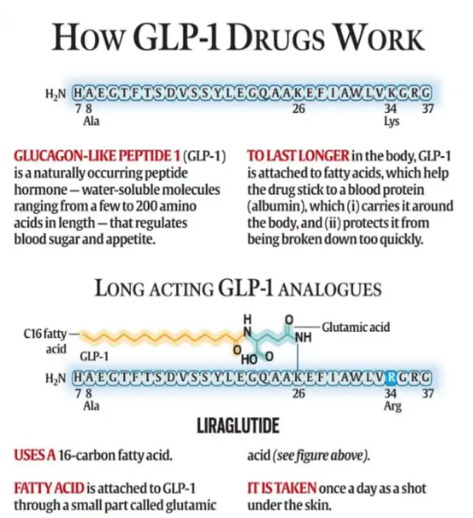Syllabus:
GS3: Science and Technology- developments and their applications and effects in everyday life
Context:
Last year, Lotte Bjerre Knudsen, Joel Habener, and Svetlana Mojsov won the Lasker-DeBakey Award for their work on GLP-1-based drugs.
More on the News
- Lotte Bjerre Knudsen is co-inventor of the first long-acting GLP-1 receptor agonist approved for the treatment of type 2 diabetes and obesity.
- The emergence of GLP-1 has shown that the brain and gut are intertwined.
- Both semaglutide and tirzepatide belong to a new class of medicines called GLP-1 (glucagon-like peptide-1) receptor agonists. They are prescribed for the management of type-2 diabetes and obesity.
- These drugs mimic certain naturally-occurring gut hormones called incretins (GLP-1 is one such incretin) produced in the small intestine, and are hence also known as incretin mimicker.
GLP-1
- GLP-1, or glucagon-like peptide-1, since a naturally occurring hormone plays a crucial role in regulating blood sugar levels and appetite.
- It is both an incretin hormone and a neurotransmitter and is secreted from the small intestine and from the hindbrain after we eat a meal.
- It travels to the pancreas, where it helps to regulate our blood sugar by increasing insulin and decreasing glucagon. This is why it is called the incretin effect.
This effect is blood glucose-dependent, meaning it is only if the blood glucose is elevated that it has an effect here.
It impacts centres in the brain associated with control of hunger and satiety, to effectively tell us that we have had enough to eat and need to stop eating. - There are receptors that GLP-1 binds to in many organs in the body.
- GLP-1 also has beneficial effects in many of these organs, such as the kidney, liver, and cardiovascular system.
- Its effects in the pancreas and brain are the important ones to help control blood glucose and body weight.
Working of GLP-1 Drug

- GLP-1 is so short-lived that it is chopped up by metabolic enzymes known as DPP-4 and cleared by the kidneys. The technique that was used is called fatty acid acylation.
- GLP-1 attaches to a fatty acid that allows the drug to bind to a natural protein called albumin via the fatty acid.
Albumin is a protein that plays a crucial role in transporting various substances throughout the body, including fatty acids. - By attaching to albumin, the drug is protected from degradation, also from being cleared by the kidneys, and ensure that it reaches the GLP-1 receptors that are present in various organs throughout the body.
- GLP-1 works for just a few minutes, so after eating a meal and GLP-1 is secreted naturally, giving an immediate effect that lasts maybe 30 minutes.
- For individuals with Type 2 diabetes, it helps to regulate their blood sugar 24 hours a day.
- In cases of obesity, it aids in controlling hunger and food intake throughout the day. If someone is at risk of cardiovascular disease, it consistently helps dampen inflammation, and lowers blood pressure and certain blood lipids.
GLP-1 Drug and Alzheimer’s
- GLP-1 receptor agonists, a class of drugs initially developed for type 2 diabetes, are showing promise as potential treatments for Alzheimer’s disease due to their neuroprotective and anti-inflammatory effects.
- Studies suggest these drugs may help slow down the progression of Alzheimer’s disease by reducing neuroinflammation, decreasing amyloid-beta deposition, and mitigating tau hyperphosphorylation, all of which are implicated in the disease’s pathology.
GLP-1’s role in brain diseases
- The central hypothesis is inflammation in the brain. Inflammation is one of the earliest processes involved in many diseases. At the tissue level, things begin to change, triggered by different pathological stimuli, whether from genetics, the environment, or other factors.
- GLP-1 receptors are spread across the brain, allowing the drug to influence brain function at the cellular level.

